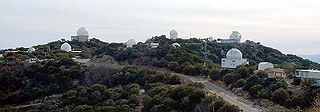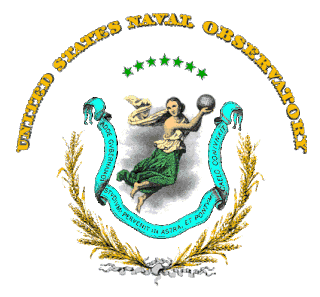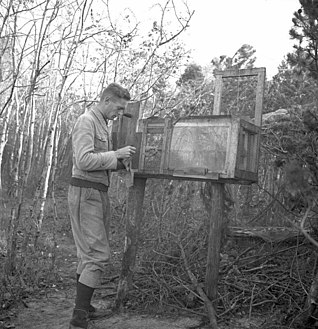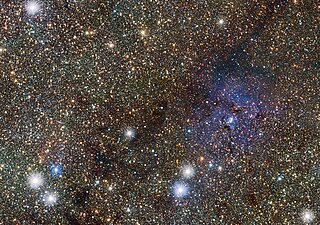
The Kitt Peak National Observatory (KPNO) is a United States astronomical observatory located on Kitt Peak of the Quinlan Mountains in the Arizona-Sonoran Desert on the Tohono O'odham Nation, 88 kilometers (55 mi) west-southwest of Tucson, Arizona. With 22 optical and two radio telescopes, it is the largest, most diverse gathering of astronomical instruments in the northern hemisphere. The observatory is administered by the National Optical Astronomy Observatory (NOAO).

A space telescope or space observatory is an instrument located in outer space to observe distant planets, galaxies and other astronomical objects. Space telescopes avoid many of the problems of ground-based observatories, such as light pollution and distortion of electromagnetic radiation (scintillation). In addition, ultraviolet frequencies, X-rays and gamma rays are blocked by the Earth's atmosphere, so they can only be observed from space.

The United States Naval Observatory (USNO) is one of the oldest scientific agencies in the United States, with a primary mission to produce Positioning, Navigation and Timing (PNT) for the United States Navy and the United States Department of Defense. Located in Northwest Washington, D.C. at the Northwestern end of Embassy Row, it is one of the pre-1900 astronomical observatories located in an urban area; at the time of its construction, it was far from the light pollution thrown off by the (then-smaller) city center. Former USNO director Gernot M. R. Winkler initiated the "Master Clock" service that the USNO still operates, and which provides precise time to the GPS satellite constellation run by the United States Air Force. The USNO performs radio VLBI-based positions of quasars with numerous global collaborators, in order to produce Earth Orientation parameters.

The Royal Observatory, Greenwich is an observatory situated on a hill in Greenwich Park, overlooking the River Thames. It played a major role in the history of astronomy and navigation, and is best known for the fact that the prime meridian passes through it, and thereby gave its name to Greenwich Mean Time. The ROG has the IAU observatory code of 000, the first in the list. ROG, the National Maritime Museum, the Queen's House and Cutty Sark are collectively designated Royal Museums Greenwich.

An observatory is a location used for observing terrestrial or celestial events. Astronomy, climatology/meteorology, geophysical, oceanography and volcanology are examples of disciplines for which observatories have been constructed. Historically, observatories were as simple as containing an astronomical sextant or Stonehenge.

Lowell Observatory is an astronomical observatory in Flagstaff, Arizona, United States. Lowell Observatory was established in 1894, placing it among the oldest observatories in the United States, and was designated a National Historic Landmark in 1965. In 2011, the Observatory was named one of "The World's 100 Most Important Places" by TIME. It was at the Lowell Observatory that the dwarf planet Pluto was discovered in 1930 by Clyde Tombaugh.

The Arecibo Observatory is a radio telescope in the municipality of Arecibo, Puerto Rico. This observatory is operated by University of Central Florida, Yang Enterprises and UMET, under cooperative agreement with the US National Science Foundation (NSF). The observatory is the sole facility of the National Astronomy and Ionosphere Center (NAIC), which is the formal name of the observatory. From its construction in the 1960s until 2011, the observatory was managed by Cornell University.

Yerkes Observatory is an astronomical observatory in Williams Bay, Wisconsin operated by the University of Chicago Department of Astronomy and Astrophysics. It closed public operations in 2018. The observatory, which called itself "the birthplace of modern astrophysics", was founded in 1897 by astronomer George Ellery Hale and financed by businessman Charles T. Yerkes. It represented a shift in the thinking about observatories, from their being mere housing for telescopes and observers, to the early-20th-century concept of observation equipment integrated with laboratory space for physics and chemistry.

The Lick Observatory is an astronomical observatory, owned and operated by the University of California. It is situated on the summit of Mount Hamilton, in the Diablo Range just east of San Jose, California, US. The observatory is managed by the University of California Observatories, with headquarters on the University of California, Santa Cruz campus, where its scientific staff moved in the mid-1960s. It is named after James Lick.

Palomar Observatory is an astronomical observatory located in San Diego County, California, United States, 145 kilometers (90 mi) southeast of Los Angeles, California, in the Palomar Mountain Range. It is owned and operated by the California Institute of Technology (Caltech) located in Pasadena, California. Research time is granted to Caltech and its research partners, which include the Jet Propulsion Laboratory (JPL) and Cornell University.

The McDonald Observatory is an astronomical observatory located near the unincorporated community of Fort Davis in Jeff Davis County, Texas, United States. The facility is located on Mount Locke in the Davis Mountains of West Texas, with additional facilities on Mount Fowlkes, approximately 1.3 kilometers (0.81 mi) to the northeast. The observatory is part of the University of Texas at Austin. It is an organized research unit of the College of Natural Sciences.

The Dominion Astrophysical Observatory, located on Observatory Hill, in Saanich, British Columbia, was completed in 1918 by the Canadian government. The Dominion Architect responsible for the building was Edgar Lewis Horwood. The main instrument is the 72 inch aperture Plaskett telescope, proposed and designed by John S. Plaskett in 1910 with the support of the International Union for Cooperation in Solar Research. It was planned to be the largest telescope in the world but delays meant it was completed and saw "first light" on May 6, 1918, 6 months after the 100-inch Hooker telescope at Mount Wilson Observatory.

The Griffith Observatory is a facility in Los Angeles, California, sitting on the south-facing slope of Mount Hollywood in Los Angeles' Griffith Park. It commands a view of the Los Angeles Basin, including Downtown Los Angeles to the southeast, Hollywood to the south, and the Pacific Ocean to the southwest. The observatory is a popular tourist attraction with a close view of the Hollywood Sign and an extensive array of space and science-related displays. Admission has been free since the observatory's opening in 1935, in accordance with the will of Griffith J. Griffith, the benefactor after whom the observatory is named.
Anderson Mesa Station is an astronomical observatory established in 1959 as a dark-sky observing site for Lowell Observatory. It is located at Anderson Mesa in Coconino County, Arizona (USA), about 12 miles southeast of Lowell's main campus on Mars Hill in Flagstaff, Arizona.
1059 Mussorgskia, provisional designation 1925 OA, is a background asteroid from the central regions of the asteroid belt, approximately 25 kilometers in diameter. It was discovered on 19 July 1925, by Soviet astronomer Vladimir Albitsky at the Simeiz Observatory on the Crimean peninsula. The asteroid was named for Russian composer Modest Mussorgsky. The X- or C-type asteroid has a rotation period of 5.636 hours.

Heidelberg-Königstuhl State Observatory is a historic astronomical observatory located near the summit of the Königstuhl hill in the city of Heidelberg in Germany. The predecessor of the current observatory was originally opened in 1774 in the nearby city of Mannheim but degradation of observational conditions there resulted in a relocation to the Königstuhl in 1898.
The King's Observatory is a Grade I listed building in Richmond, London. Now a private dwelling, it formerly housed an astronomical and terrestrial magnetic observatory founded by King George III. The architect was Sir William Chambers; his design of the King's Observatory influenced the architecture of two Irish observatories – Armagh Observatory and Dunsink Observatory near Dublin.

The Hong Kong Observatory is a weather forecast agency of the government of Hong Kong. The Observatory forecasts the weather and issues warnings on weather-related hazards. It also monitors and makes assessments on radiation levels in Hong Kong and provides other meteorological and geophysical services to meet the needs of the public and the shipping, aviation, industrial and engineering sectors.

The Rossitten Bird Observatory was the world's first ornithological observatory. It was sited at Rossitten, East Prussia, on the Curonian Spit on the south-eastern coast of the Baltic Sea. It was established by German ornithologist Johannes Thienemann and operated until 1944. In 1945 East Prussia was divided between Poland, Russia and Lithuania, and most ethnic Germans expelled.




















